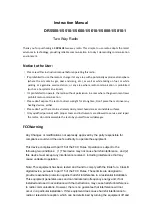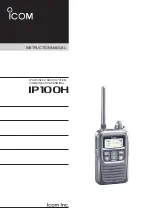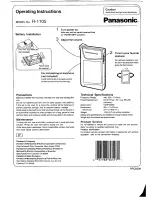
Instruction Manual
DR5500-1/5510-1/5600-1/5610-1/5800-1/5810-1
Two Way Radio
Thank
you
for
purchasing
a
COVALUE
two
‐
way
radio.
This
simple
to
use
radio
adopts
the
latest
advances
in
technology,
providing
reliable
communication
in
today’s
demanding
communication
environment.
Notice
to
the
User:
·
Please
read
this
instruction
manual
before
operating
this
radio.
·
It’s
prohibited
to
use
the
radio
or
charge
it
at
any
area
with
a
potentially
explosive
atmosphere
(where
the
air
contains
gas,
dust
and
smog,
etc.),
as
well
as
while
taking
on
fuel,
or
while
parking
at
a
gasoline
service
station;
or
any
area
where
radio
communication
is
prohibited
(such
as
a
hospital
or
an
airport.)
·
It’s
prohibited
to
operate
the
radio
without
permission
in
areas
where
the
government
laws
prohibit
radio
communication.
·
Please
don't
expose
the
radio
to
direct
sunlight
for
a
long
time;
Don't
place
the
radio
near
any
heating
devices,
either.
·
Please
don't
put
the
radio
in
extremely
dusty,
moist
humid
areas
or
unstable
surfaces.
·
Only
qualified
personal,
with
proper
tools
and
instruments
are
allowed
to
service
and
repair
the
radios,
do
not
disassemble
the
radio
by
yourself
to
avoid
damages.
FCCWarning
:
Any Changes or modifications not expressly approved by the party responsible for
compliance could void the user’s authority to operate the equipment.
This device complies with part 15 of the FCC Rules. Operation is subject to the
following two conditions: (1) This device may not cause harmful interference , and (2)
this device must accept any interference received , including interference that may
cause undesired operation .
Note: This equipment has been tested and found to comply with the limits for a Class B
digital device, pursuant to part 15 of the FCC Rules. These limits are designed to
provide reasonable protection against harmful interference in a residential installation.
This equipment generates uses and can radiate radio frequency energy and, if not
installed and used in accordance with the instructions, may cause harmful interference
to radio communications. However, there is no guarantee that interference will not
occur in a particular installation. If this equipment does cause harmful interference to
radio or television reception, which can be determined by turning the equipment off and





























